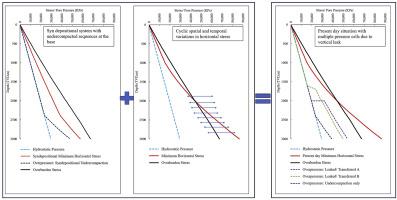文莱l型孔隙压力斜坡的意义:盆地中压缩诱导的垂直流体流动及其对含油气系统的影响
IF 3.6
引用次数: 0
摘要
随着井控能力的提高、高质量的地震数据集以及钻井过程中主动的实时超压监测,勘探钻井超压预测在大多数盆地都变得越来越强大。然而,尽管有几十年的钻井经验,在西北婆罗洲海上,准确的超压预测仍然具有挑战性。本文以文莱壳牌石油公司相隔40年的两口勘探井为研究对象,这两口勘探井在超压预测和井控方面面临着类似的挑战。利用地震和测井数据进行综合回顾研究,探讨这些井在钻前和实时操作环境中孔隙压力预测(PPP)结果不理想的原因。我们的研究表明,对超压的错误预测是由于页岩压力(钻前工作和监测的基础)和砂压(钻涌和井控挑战的来源)的实际差异造成的,这是由于大规模的垂直泄漏或深层流体通过剪切和拉伸破坏机制混合排出到几个地区的预压正常压力的上覆沉积物中。在页岩压力保持较低的情况下,这种运移流体会使通常压实的浅层层序中的砂压膨胀。尝试了向上流体排出的预测框架,但由于导致这种泄漏的水平应力场的复杂时空变化,发现不可行。因此,这些迁移超压力从传统的PPP工作流程来看,基本上是“不可预测的”,从压实不平衡(欠压实)和流体膨胀(卸载)机制来看。建议进行进一步的研究,以了解这种在砂岩中迁移的超压是否可以在邻近的正常压实页岩中产生可识别和可预测的地球物理或岩石物理特征。该研究强调了婆罗洲西北部等构造地层演化复杂地区同一地层单元内砂体超压横向变化较大的可能性。本文章由计算机程序翻译,如有差异,请以英文原文为准。

Making sense of the L-shaped pore pressure ramps in Brunei: Compression-induced vertical fluid flow in the basin and its impact on the petroleum system
Overpressure prediction for exploratory drilling has become robust in most basins with increasing well control, high-quality seismic datasets, and proactive real-time overpressure monitoring while drilling. However, accurate overpressure prediction remains challenging in offshore Northwest Borneo despite several decades of drilling experience. This paper focuses on two exploration wells drilled by Brunei Shell Petroleum 40 years apart that faced similar challenges with overpressure prediction and well control. An integrated lookback study is attempted using seismic and well-log data to explore the causes of the unsatisfactory Pore Pressure Prediction (PPP) outcome in pre-drill and real-time operation settings for these wells.
Our study indicates that the misprediction of overpressures is due to real differences in shale pressure (basis of pre-drill work and monitoring) and sand pressure (source of drill kick and well control challenges) due to large-scale vertical leak or expulsion of deep-seated fluids into pre-compacted normally pressured overlying sediments in several regions through a mix of shear and tensile failure mechanisms. Such migrated fluids inflate the sand pressure in the normally compacted shallower sequences with the shale pressure remaining low. A predictive framework for upward fluid expulsion was attempted but found impracticable due to complex spatial and temporal variations in the horizontal stress field responsible for such leakage. As such, it is proposed that these migratory overpressures are essentially ‘unpredictable’ from conventional PPP workflows viewed in the broad bucket of compaction disequilibrium (undercompaction) and fluid expansion (unloading) mechanisms. Further study is recommended to understand if such migrated overpressures in the sand can produce a discernible and predictable geophysical or petrophysical signature in the abutting normally compacted shales.
The study highlights the possibility of large lateral variability in the sand overpressure within the same stratigraphic unit in regions with complex tectonostratigraphic evolution like Northwest Borneo.
求助全文
通过发布文献求助,成功后即可免费获取论文全文。
去求助

 求助内容:
求助内容: 应助结果提醒方式:
应助结果提醒方式:


